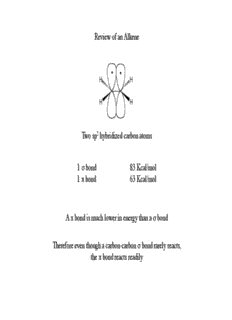
Review of an Alkene - The University of Texas at Dallas PDF
Preview Review of an Alkene - The University of Texas at Dallas
Review of an Alkene Two sp2 hybridized carbon atoms 1 σ bond 83 Kcal/mol 1 π bond 63 Kcal/mol A π bond is much lower in energy than a σ bond Therefore even though a carbon-carbon σ bond rarely reacts, the π bond reacts readily Double Bond Prevents Rotation A carbon-carbon single bond has conformational flexibility The carbon-carbon double bond prevents this rotation because the π bond would have to break for rotation to occur This Lack of Rotation Causes Geometric Isomers -if two substituents are on the same side of the double bond called CIS cis-2-butene -if two substituents are on opposite sides of the double bond called TRANS trans-2-butene If there are more than two substituents on alkene use Z and E nomenclature -substituents are prioritized (same rules as already learned for R and S designation) -if the highest priorities are on the same side called Z 2 2 Z – zusammen – “together” Z-2-bromo-2-butene 1 1 -if the highest priorities are on the opposite side called E 2 1 E – entgegen – “opposite” 1 2 E-2-bromo-2-butene Stability of Alkenes We have already seen Zaitsev’s rule which implies as the number of alkyl substituents increases the stability of the alkene increases (structure is of lower energy) We can rationalize this by considering an alkene as two adjacent carbon radicals Radicals are electron deficient Therefore anything that stabilizes electron deficient sits will stabilize an alkene (carbon-carbon bonds are electron donating through inductive and hyperconjugation effects) Stability also changes between disubstituted alkenes Consider again cis- versus trans-2-butene The cis isomer has higher nonbonded strain Ring Strain A small ring requires a cis geometry In a ring structure, a trans alkene is too high in energy until at least an eight membered ring In smaller rings therefore any alkene in a ring is assumed to be cis (do not need to write cis) Synthesis of Alkenes We have already learned two ways to synthesize an alkene: 1) Dehydrohalogenation (either E1 or E2) -eliminate a hydrogen and halogen from an alkane to generate a double bond 2) dehalogenation Eliminate two adjacent bromines from an alkane with iodide ion Goes through an anti-coplanar elimination similar to an E2 mechanism A third route to alkenes is through a dehydration of an alcohol Under acidic conditions an alcohol can leave to generate a carbocation This carbocation can react similar to E1 reactions studied earlier to generate an alkene
Description: